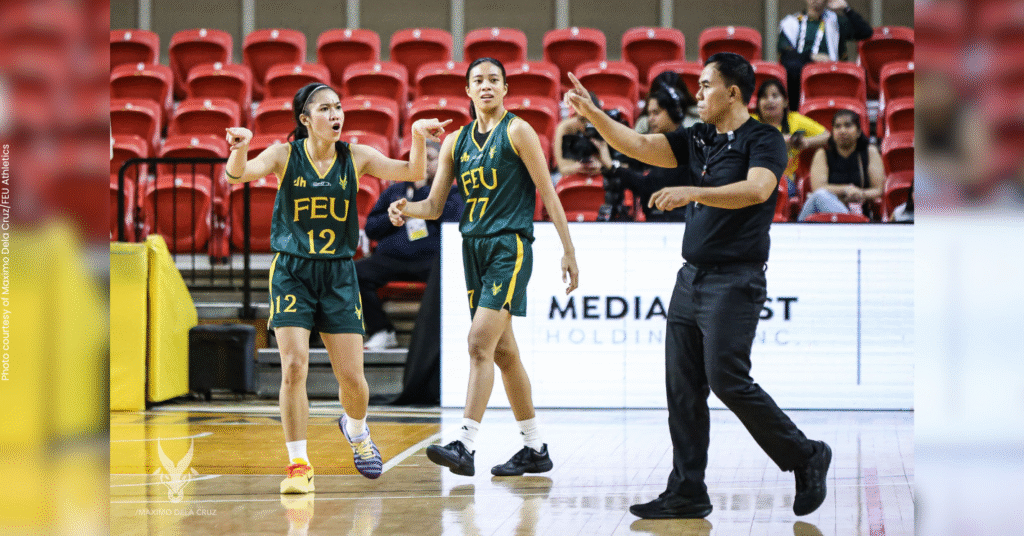
Armas ng kakanyahan: Pagsibak sa panaghoy ng Anti-Terrorism Law
- February 11, 2024 08:07
FEU Advocate
October 14, 2025 20:54

Ace
By Angel Joyce C. Basa, Senior Sports Writer
Two seasons ago, we saw progress. Two seasons later, the University Athletic Association of the Philippines (UAAP) women’s basketball division is back to square one with a lower pay rate for its officiating heads and only a second-rate division after the men’s. As if striving for an equal recognition is not hard enough, the league further makes this goal impossible to attain.
It was once a cause for celebration when news broke that the women’s basketball tournaments would be broadcast alongside the men’s. However, the UAAP’s recent statement seems to have gone the other way on the matter, disclosing that the Season 88 basketball tourney referees are being paid on a merit-based structure—with the women’s division games being the lowest.
During past seasons, the pay was set at P2,500 regardless of division. As initially reported by SPIN.ph, the pay structure now values the men’s division with the highest fee per game at P3,000, the boys’ at P2,500, while the women’s and girls’ referees will only receive P2,000.
From an outsider’s perspective, the fee itself is not as bad as it seems. However, looking at the thousand-peso disparity and the sudden unnecessary change, the system disrespects not only the referees, but every single woman in sports.
According to UAAP basketball commissioner Jai Reyes, the basis of the reduced pay for the referees is the perceived difficulty level of officiating the men’s games as compared to the women’s games.
For a league that has had some progressive changes through the years, I see no reason for an abrupt need in changing pay policies, especially based on such a controversial claim that there is a difference in officiating the men’s and women’s games. These changes not only hurt the referees who work hard to ensure the integrity of each game, but also the overall systemic growth of the league. At the end of the day, it is still basketball, is it not?
It is also ridiculous that they claim to inspire female athletes to dream high while simultaneously undermining the role of women’s basketball by lowering the quality of pay and treatment its players, coaches, and referees receive. And if that is the case, it is like saying that the women’s games are not worthy of the best officiating there is to offer.
This regression from crediting women and the growing popularity of the division to downsizing its worth has awakened the voices of women in the field of sports. So much so that some sports personalities have already expressed their frustration regarding the issue.
In an interview with FEU Advocate, Far Eastern University Lady Tamaraws head coach Raiza Palmera-Dy questioned the sudden change in the pay system.
“Kasi, actually, ganoon naman ‘yung rate nila last season. It’s pare-pareho. But now, why [do] they need to cut sa women’s division and add sa [men’s] seniors? Why not maintain the women’s and add sa [men’s] seniors?” she stressed.
She emphasized that all referees worked hard to be able to officiate in the UAAP, going through the rigorous training and certifications, thus the call for an equal pay.
The crudeness of the situation had even reached the height of seated female politicians with Senator Pia Cayetano, a principle author of the Republic Act 9710 or the Magna Carta of Women, calling out the unfair and discriminatory system.
Meanwhile, Gabriela Women’s Party Representative Sarah Elago also joined the cries for the equal treatment of referees across all divisions.
As if this local havoc is not enough, halfway across the globe, the Women’s National Basketball Association (WNBA) is also under fire for alleged substandard officiating raised by their own athletes.
WNBA star Napheesa Collier voiced out what many other athletes have been enduring throughout the years during her 2025 season exit interview, calling out the league’s governing body for its negligence in handling and compensating the players.
Following the controversy, all eyes are now on the UAAP and the WNBAas any action made could be taken as a genuine resolution for the discriminatory treatment towards the division and the referees, or a performative act to save face.
Luckily for us, women are never afraid of taking a stand for equality. This is reflected by Go Hard Girls’ open letter initiative to the Philippine Commission on Women aiming to spark a conversation regarding the pay disparity—garnering over 200 signatories as of writing.
As a woman whose greatest fear is to be seen as small in such a male-dominated field, this issue seems like a nightmare turned into a reality. Because if they can easily change policies for the referees, who knows how soon they’ll do the same for the female athletes?
And soon, this movement might still be insufficient to deter these huge organizations from launching discriminatory policies and statements, because in reality, all they ever care about is the revenue they get from mainstream sports.
Nevertheless, the fight does not stop with a letter and a clarification statement. As long as there is insufficient support for women in basketball, there will never be real progress to celebrate. In the end, it all boils down to how the UAAP sees women in sports: a less competitive scene and an underplayed category only deserving of second-rate policies.
(Photo courtesy of Maximo Dela Cruz/FEU Athletics)









